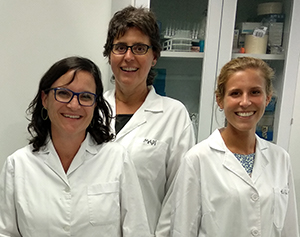Hexenyl butyrate
The IBMCP (UPV-CSIC) shows that tomato aroma protects plants from bacterial attacks
[ 10/01/2019 ]
Tomato plants emit an aroma in order to resist bacteria attacks. This volatile compound is named hexenyl butyrate (HB) and, according to the test done by researchers at the Institute for Plant Molecular and Cellular Biology (IBMCP), joint center of the Universitat Politècnica de València (UPV) and the Spanish National Research Council (CSIC, in Spanish), has great potential for protecting crops from infections, drought, etc. The finding has been published in the journal Frontiers in Plant Science.
"The application of this compound in fields will allow the industry to have a new natural strategy for improving crop yields: treatments will protect crops from biotic and abiotic stress easily, efficiently and at a low cost", says Purificación Lisón, researcher at the IBMCP(UPV-CSIC)
This compound can be used for closing the stomata, which is the key in protecting plants. According to the researchers at IBMCP, there are no other products on the market with these properties, hence why it is very significant for the farming industry. Another advantage is that it is easy to use. Since it is a volatile compound, it can be applied by spraying onto plants and also by using diffuser devices.
The properties of this compound include zero toxicity -its use is also approved in food- and it has a low cost. In addition, it is easily synthetized and according to the tests done at the laboratories of the IBMCP, it is highly efficient, so the users don't need to apply high doses.
The researchers have proven that the treatment of the tomato plants with this compound causes the closing of the stomata and protects them from infection by the Pseudomonas syringae bacteria, increasing their resistance to it. In addition, they have observed that the treated tomato plants are more tolerant to drought. They have also confirmed its efficiency in causing the stomata-closing in several species of vegetables, especially from the tomato, corn, alfalfa citrus and tobacco families.
"This is what we have demonstrated up until this point, but the compound has huge potential. It can be used as a protective barrier against situations such as drought and to protect plants from other infections produced by several pathogens whose entrance door is the stomata", says Purificación Lisón, researcher at the IBMCP (UPV-CSIC).
Controlled ripening
Another application could be controlling fruit development and the ripening processes. In those cases, treatment with the compound could be used in order to cause, in a controlled manner, treated plants to enter into a sort of induced "lethargy", as the stomata-closing involves delaying the development processes. This could provide farmers a new strategy for controlling harvest times and adjust them better to the needs of the market.
In this work has also collaborated the Department of Horticultural Sciences of the University of Florida (USA).
Outstanding news
 ARWU 2023
ARWU 2023
The Shanghai ranking reaffirms the UPV as the best polytechnic in Spain for yet another year
 Science Meets Regions CV 2023
Science Meets Regions CV 2023
The UPV and the Almussafes City Council begin a collaboration in search of solutions to maintain the automobile sector in the Valencia Region
 Scientific reference
Scientific reference
Avelino Corma, Distinguished Research Assistant at the UPV, awarded an Honorary Doctorate by the University of Huelva
 Micronanofabs NTC UPV-PERTE CHIP Conference
Micronanofabs NTC UPV-PERTE CHIP Conference
María Marced, TSMC Europe president: "The sector's future is bright, the market is expected to double by 2030"
 Goya nomination
Goya nomination
Javier Polo, who holds a degree in Audiovisual Communication from the UPV, directs the successful short documentary Una terapia de mierda
 Sant Carles Medal 2023
Sant Carles Medal 2023
The Faculty of Fine Arts of the UPV awards the Sant Carles Medal 2023 to outstanding Valencian art and culture figures







